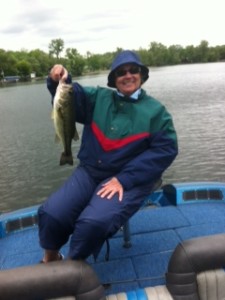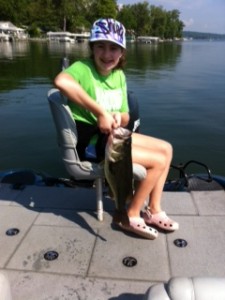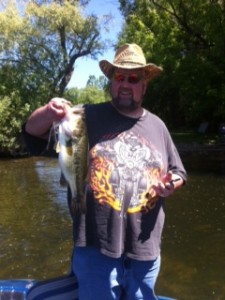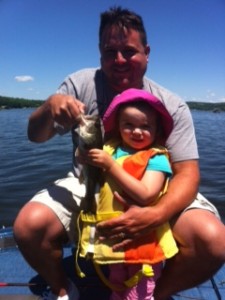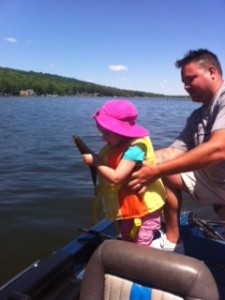Honeoye has been its typical self in late summer/pre fall fishing arena. Bass are already starting their transition and can be on the bite one day and turned off the next. I have had the best results in the 6-8 foot depth range. Move in and out until you find their desired depth on a particular day. Some days, that depth will change quickly as the water warms up after a cool night. Water temperatures are dropping quickly and with the daytime temperatures low, bass instinctively know that winter is approaching. This is a good time to use lipless crank baits, jerk baits and spinnerbaits. A buzz bait over weed beds can trigger some awesome bites. As the water cools more, flip the thicker weeds or downsize and throw 4 inch worms or french fries.
A trip to Keuka was slower than normal. A bright, sunny, calm day, made it nice to be on the water, but I prefer a small chop and a little cloud cover. The fishing always seems to be better on the ultra clear lakes when you have some help from Mother Nature to deflect light through waves and clouds. We caught some smallmouths and largemouths, but none up to my standards.
Sodus Bay was a test last week. I always enjoy a trip to Sodus as the largemouth fishing is great. At home Friday, when I went to my boat to get things ready, I found several reel handles had been chewed by squirrels. When I arrived at the ramp on Saturday, my boat would not start, thanks to the squirrels chewing the ignition wires. Needless to say, I spent the day fishing close-by weedbeds using my trolling motor. I caught two LM on a buzz bait, and then started flipping a brush hog. Total catch for the day was in the neighborhood of 15 bass and one pike bite off. The weather was marginal at best with wind, rain and very cool temperatures. I did not get any big bites, as I could not travel to my priority areas, but had a fun day, nonetheless.
SEVERAL WEEKS AGO THE D&C IN ROCHESTER PUBLISHED AN EDITORIAL CONCERNING THE SPREAD OF INVASIVE SPECIES IN THE FINGER LAKES: THIS WAS MY RESPONSE.
Maintaing Local Lakes Quality Editorial
I read and reread your opinion and praise of the politicians who are stepping forward to pass more legislation to help protect our cherished Finger Lakes. The joke of this article is in passing more legislation. Let me give you some history concerning these problems.
Most of the invasive plant species arrived here from importation by landscape and aquarium businesses pursuing a profit. Some of these plants spread by seeding and others by people disposing of them in the nearest ditch, creek, or any other convenient place they could locate. Now these plants are spreading from one body of water to another. Understandably, all boaters should do their best to help stop this transfer. The majority of boaters do a good job of cleaning up their boats after use. So where do we pick up the weeds?
I do have an answer to that question. Years ago laws were passed to tax fishing equipment, hunting equipment, and fuel, with these taxes being returned to the states on a per capita basis from license sales for fishing and hunting. At the time, the boat launches were controlled by the DEC, and there was no fee to use them. Fast forward to our elected leaders. They have found a cash cow by making the boat launches NYS parks and charging a fee for use. Fees now range from $6 to $7 to use these boat ramps. Personnel were hired to collect those fees and do some minor duties. Today, our leaders have installed electronic kiosks to replace the former attendant. Now we have several ramps with no attendants during the busy summer season.
As the invasive species problem grew, our leaders appropriated funds to do a study at the boat launches. College students would inspect your boat before you launched it and after it was retrieved. One of their questions was, what body of water were you on last. While speaking to the student at Conesus Lake Park, I asked her if she realized where the weeds came from on my boat and trailer. She replied from the lake. Technically she was correct, but I pointed out to her that a weed has not been grown that can stay on a bass boat at 45 miles per hour. The weeds get on the boat and trailer at the boat launch when the boat is loaded onto the trailer. Why? Because our leaders, being so much smarter than us, know, instead of cleaning the boat ramp of weeds, why not lay off the personnel who could clean the ramp. Instead, they pass new legislation and add paperwork that will always replace hard work.
It is a shame that the very people we rely on to address these types of problems are so misinformed. With all the waste of funds in Albany and Washington, a small stipend to man these launches would do much more to help control the spread of invasive species than all of the legislation they pass.
F.H.Tennity
Honeoye Lake Resident


